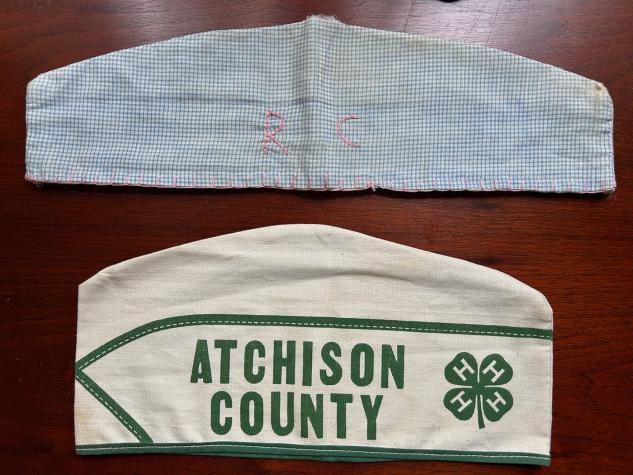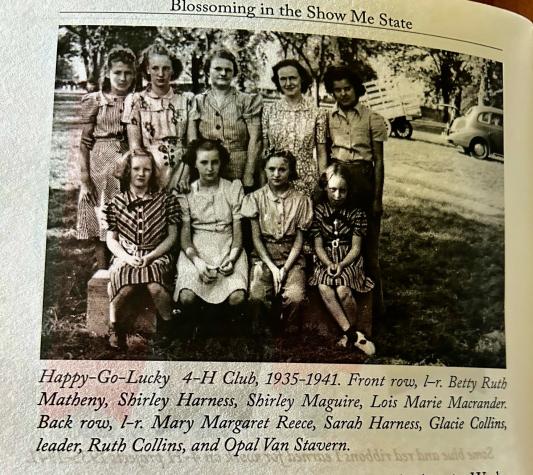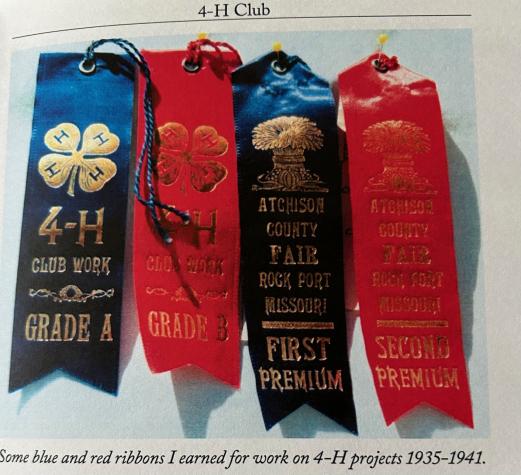A package recently arrived at the Missouri 4-H Foundation’s office in Columbia. Inside was a 1930s-era 4-H cap and a perfectly preserved sewing project — a gingham checked coat hanger cover with precise pink stitching spelling out the initials R.C.
The items, along with a memoir, “Blossoming in the Show Me State,” chronicle the early years of Ruth Collins McQuerry, who grew up on a farm in northwestern Missouri.
Ruth eventually married Wayne McQuerry, a Navy reservist. The couple went on to live in different states for Wayne’s service and work in teaching, sales and aerospace. After retiring to California, they traveled extensively, including overseas. But Ruth’s roots reach back to the Atchison County Happy-Go-Lucky 4-H Club, of which she was a member from 1935 to 1941. Her daughter Patricia Usary shared her late mother’s memorabilia in hopes others would enjoy the glimpse into times past.
In a chapter devoted to her time in 4-H, Ruth recalled that Georgia Hedrick, her county school teacher at Eureka, “introduced her students to this wonderful program. Projects included sewing, woodworking and perhaps others that I don’t recall.” Ruth’s mother led the club’s sewing section, teaching the rudiments of hand sewing, including embroidery, as well as how to use her Damascus treadle sewing machine and insisting that seams be ripped out and redone until straight.
“That was a challenge!” Ruth wrote. “Keeping the machine running smoothly required rhythmic coordination of feet pumping the treadle and hands guiding pieces of cloth. In the beginning my legs didn’t quite reach the treadle. With the introduction of hand sewing and sewing machine, we hemmed dishtowels and embroidered designs, make simple blouses and aprons. And eventually skirts and dresses.”
Ruth often exhibited at the county fair, winning blue and red ribbons for her work. She’d sometimes participate in a revue wearing a garment she’d made, such as a navy blue wool skirt, white shirtwaist blouse and blue plaid tailored jacket.
At age 41, her father bought his own farm, where he grew hay, corn, wheat, oats and soybeans. In the early days, he still used draft horses to pull the implements. None of the 4-H club members lived in homes with electricity.
In the summer of 1941, as she was readying to start college, her 4-H club planned a camping trip to Crystal Lake in College Springs, Iowa.
None of the girls’ mothers could take time from “gardening, canning fruits and vegetables or cooking meals for extra farm hands” to serve as chaperones. It was decided that Ruth, at age 17, was old enough to chaperone the seven or eight girls who were going. “The week went smoothly” with the usual fun camping activities, such as making s’mores. “It was a memorable conclusion to my 4-H activities,” Ruth relates, with incredulity that a girl of 17 would be entrusted with such responsibility.
Her daughter Patricia wrote in an email, “Growing up during the Depression, Mother had to be adaptive and creative in making things. Her journey after high school was a challenge to a very shy country girl.”
Ruth was the first person in her family to attend college, at Northwest Missouri State Teacher’s College in Maryville, where she studied to become a home economics teacher.
“She had never been away from home before going to college and she had to work for her room and board,” Patricia wrote. “She never was afraid of hard work and instilled that in each of us as we grew. When she taught high school, she took that creativity to challenge the girls in a cooking class to bake cakes, pies, and cookies using different sweeteners as sugar had been rationed in WWII. They had to compare taste, texture and aroma.
“As an adult, she was a member of Kappa Omicron Phi, that she joined in college and stayed an active member for a number of years. She also continued to take classes to further her education in sewing, tailoring and quilting. Both she and my dad took writing classes through the park and recreation department in Orange County (California), and that’s where her book came to be.”
Writer: Katherine Foran


